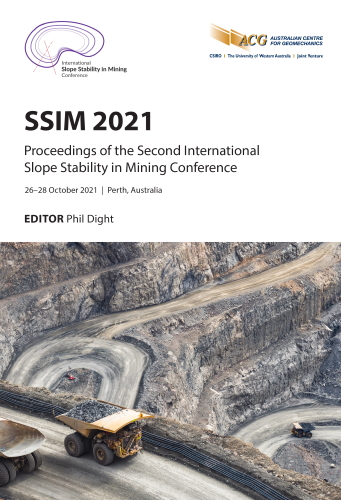Structural data bias assessment at Jwaneng Mine

|
Authors: Gabanakgosi, K; Mogorosi, O; Rametlae, K; Boitshepo, B; Barei, OM |
DOI https://doi.org/10.36487/ACG_repo/2135_08
Cite As:
Gabanakgosi, K, Mogorosi, O, Rametlae, K, Boitshepo, B & Barei, OM 2021, 'Structural data bias assessment at Jwaneng Mine', in PM Dight (ed.), SSIM 2021: Second International Slope Stability in Mining, Australian Centre for Geomechanics, Perth, pp. 159-174, https://doi.org/10.36487/ACG_repo/2135_08
Abstract:
Successful delivery of a life-of-mine plan largely depends on the reliability and performance of the geotechnical models. Assessments of the reliability of the geotechnical model have therefore become a key focus in managing mining operations. A major risk to the reliability of the geotechnical model is data confidence, and the focus for every mine site is on the key aspects affecting the design and stability of mine excavations. Stability of the mining excavation is controlled in large by geology and structures. In this regard, the confidence in data used to confirm the geology is critical. Pertinent for mines affected by geological structures is an assessment of data bias as structures not appropriately defined could be detrimental to the mine’s stability. Jwaneng Mine’s open pit stability is controlled by steeply dipping bedding daylighting into the pit on the eastern slopes and dipping into the walls on the western slopes. Data confidence in relation to the data collection method has been carried out. This includes spatial resolution, accuracy and precision of the chosen data collection method, as well as bias. Extensive geotechnical data collection through drilling and pit face mapping has been undertaken throughout the life-of-mine. Data collection methodologies have been discussed which informed the data source selection from respective data collection methodologies. Low quality datasets were excluded and assessment was made as to whether significant data gap (spatial) will arise due to exclusion of these datasets. This was, however, not realised as Jwaneng Mine has extensive data coverage, but it presented an opportunity for retrospective assessment of potential data bias. Bias assessment undertaken from the data covered a review of existing drillhole core orientations and mapped discontinuity orientations. Stereonet plots, and 3D plotting of the drillholes, together with discontinuity from geophysical televiewer logs were used for the bias assessment. Evident from the assessment is bias that results from unfavourable drillhole orientation with respect to certain geological structures. The methodology provided a means of proactively realising the gaps and adequately addressing them. This has proven to be valuable knowledge that can be shared with the industry such that mine design studies, as well as operation design reviews, should include it in order to ensure the mine design objectives are successfully delivered.
Keywords: slope design, slope stability, model reliability, data confidence, data bias
References:
Barnett, WP 2009, Jwaneng Country Rock Model Update, SRK Consulting.
Barnett, WP 2016, Jwaneng 2016 Fabric Model Update, SRK Consulting.
Barton, CA & Zoback, M 1992, ‘Self-similar distribution and properties of macroscopic fractures at depth in crystalline rock in the Cajon Pass scientific drill hole’, Journal Of Geophysical Research-Solid Earth, vol. 97, issue B4, pp. 5181–5200.
Beukes, NJ 2006, Stratigraphy of the Transvaal Supergroup at Jwaneng Mine in Botswana, Jwaneng Phase 2 Report, KLM Consulting Services (Pty) Ltd, Lanseria.
Creus, PK, Basson, IJ, Stoch, B, Mogorosi, O, Gabanakgosi, K, Ramsden, F & Gaegopolwe, P 2017, ‘Structural analysis and implicit 3D modelling of Jwaneng Mine: insights into deformation of the Transvaal Supergroup in SE Botswana’, Journal of African Earth Sciences, vol. 137, pp. 9–21.
Fowler, MJ 2013, ‘Structural data bias in the digital age’, in PM Dight (ed.), Slope Stability 2013: Proceedings of the 2013 International Symposium on Slope Stability in Open Pit Mining and Civil Engineering, Australian Centre for Geomechanics, Perth,
Gabanakgosi, K, Mosebi K, Mogorosi, O, Barei OM, Ntlotlang, K & Thokweng T, 2018, ‘A multi-disciplinary approach to dip slope mining in Jwaneng Mine, Botswana’, Proceedings of the 2018 International Symposium on Slope Stability in Open Pit Mining and Civil Engineering, Seville.
Laing, W 2005, ‘The data gap in geology and its implication for resource estimation’, Australian Institute of Geoscientists, Bulletin 42, pp. 37–53.
Massiot, C, Lewis, B, Prince, L, Bignall, G, McNamara & David, D 2012, ‘Statistical corrections of fracture sampling bias in boreholes from acoustic televiewer logs’, Proceedings of the New Zealand Geothermal Workshop.
Mogorosi, O, Gabanakgosi, K, Barei, OM & Thokweng, T 2017, ‘Slope stability challenges and solutions for mining kimberlite resources hosted in structurally complex country rock: dip slope mining at Jwaneng Mine, Botswana’, Proceedings of the 11th International Kimberlite Conference, vol. 11, Gaborone.
Read, J & Stacey, P 2009, Guidelines for Open Pit Slope Design, CSIRO Publishing, Collingwood.
Stead, D & Wolter, A 2015, ‘A critical review of rock slope failure mechanisms: the importance of structural geology’, Journal of Structural Geology, vol. 74, pp. 1–23.
Steffen, OK, Terbrugge, PJ, Wesseloo, J, Venter, J & Stacey, TR 2006, ‘A risk consequence approach to open pit slope design’, Journal of the South African Institute of Mining and Metallurgy, vol. 106, no. 7, pp. 503–511.
Terzaghi, RD 1965, ‘Sources of error in joint surveys’, Géotechnique, vol. 15, pp. 287–304.
Verma, D, Thajera, R, Kainthola, A & Singh, TN 2011, ‘Evaluation of Open Pit Mine Slope Stability Analysis’, International Journal of Earth Science and Engineering, vol. 4, No. 4, pp. 590–600.
© Copyright 2025, Australian Centre for Geomechanics (ACG), The University of Western Australia. All rights reserved.
View copyright/legal information
Please direct any queries or error reports to repository-acg@uwa.edu.au
View copyright/legal information
Please direct any queries or error reports to repository-acg@uwa.edu.au